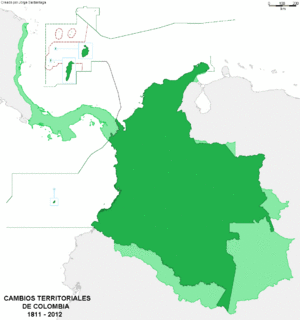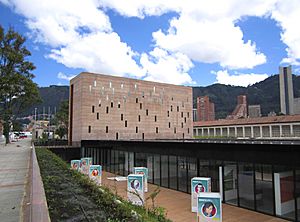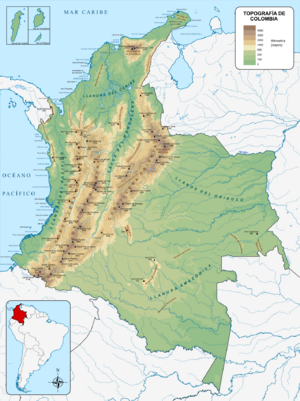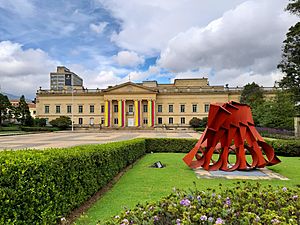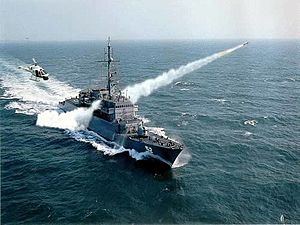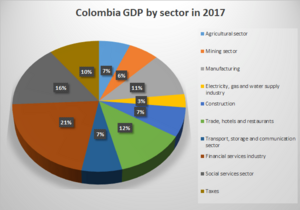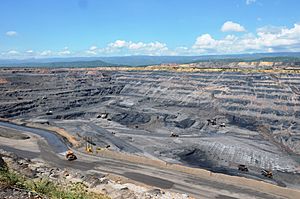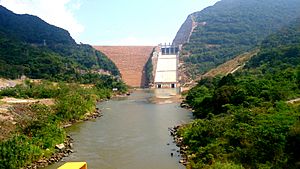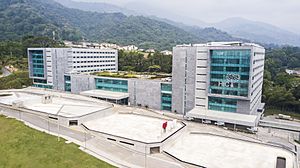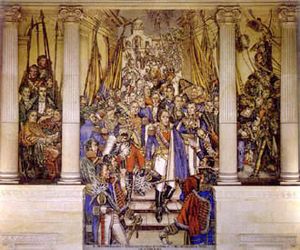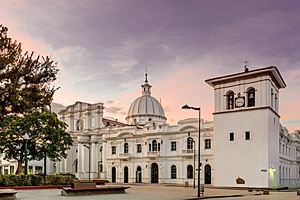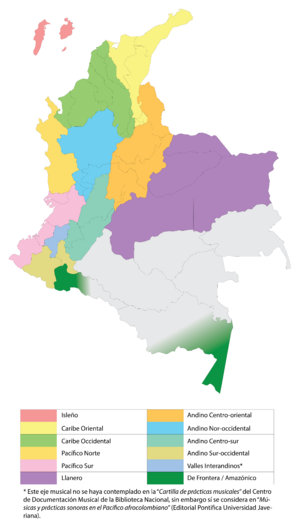Colombia facts for kids
Quick facts for kids
Republic of Colombia
República de Colombia (Spanish)
|
|
|---|---|
|
Motto: "Libertad y Orden" (Spanish)
"Freedom and Order"
|
|
|
Anthem: Himno Nacional de la República de Colombia (Spanish)
"National Anthem of the Republic of Colombia" |
|
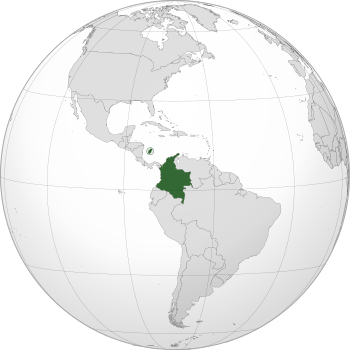
Location of Colombia (dark green)
|
|
| Capital and largest city
|
Bogotá 4°35′N 74°4′W / 4.583°N 74.067°W |
| Official languages | Spanish |
| Recognized regional languages | Creole English (in San Andrés and Providencia) 64 other languages |
| Ethnic groups
(2018 census)
|
|
| Religion
(2022)
|
|
| Demonym(s) | Colombian |
| Government | Unitary presidential republic |
| Gustavo Petro | |
| Francia Márquez | |
| Legislature | Congress |
| Senate | |
| Chamber of Representatives | |
| Independence from Spain | |
|
• Declared
|
20 July 1810 |
|
• Recognized
|
7 August 1819 |
|
• Last unitisation
|
5 August 1886 |
|
• Secession of Panama
|
6 November 1903 |
|
• Current Constitution
|
4 July 1991 |
| Area | |
|
• Total
|
1,141,748 km2 (440,831 sq mi) (25th) |
|
• Water (%)
|
2.1 (as of 2015) |
| Population | |
|
• 2024 estimate
|
|
|
• Density
|
46.15/km2 (119.5/sq mi) (174th) |
| GDP (PPP) | 2024 estimate |
|
• Total
|
|
|
• Per capita
|
|
| GDP (nominal) | 2024 estimate |
|
• Total
|
|
|
• Per capita
|
|
| Gini (2022) | ▲ 54.8 high |
| HDI (2022) | high · 91st |
| Currency | Colombian peso (COP) |
| Time zone | UTC−5 (COT) |
| Date format | DMY |
| Driving side | right |
| Calling code | +57 |
| ISO 3166 code | CO |
| Internet TLD | .co |
|
|
Colombia, officially the Republic of Colombia, is a country mostly in South America. It also has islands in North America. Colombia is bordered by the Caribbean Sea to the north and the Pacific Ocean to the west. It shares land borders with Venezuela, Brazil, Ecuador, Peru, and Panama.
Colombia is divided into 32 departments. Its capital and largest city is Bogotá. Other big cities include Medellín, Cali, and Barranquilla. Colombia covers about 1.14 million square kilometers (440,831 sq mi) and has a population of around 52 million people. It is the largest Spanish-speaking country in South America.
Colombia's culture is a mix of influences from Europe, Africa, and the Indigenous people who lived there before colonization. Spanish is the official language. However, English and 64 other languages are also recognized in certain areas.
People have lived in Colombia since at least 12,000 BCE. The Spanish arrived in 1499 and colonized much of the area by the mid-1500s. They created the New Kingdom of Granada. Colombia gained independence from Spain in 1819. It became the United Provinces of New Granada. The country changed its name several times before becoming the Republic of Colombia in 1886. Panama separated from Colombia in 1903.
Colombia is one of the world's 17 "megadiverse" countries. This means it has a huge variety of plants and animals. It has the third-highest level of biodiversity globally. Its land includes parts of the Amazon rainforest, high mountains, grasslands, and deserts. It is the only country in South America with coastlines on both the Atlantic and Pacific oceans. Colombia is an important member of many global groups like the UN and the WTO. Its economy is the third-largest in South America.
Contents
What Does the Name "Colombia" Mean?
The name "Colombia" comes from the last name of the Italian explorer Christopher Columbus. It was meant to refer to all of the "New World." The name was later used for the Republic of Colombia in 1819. This republic included parts of modern-day Colombia, Panama, Venezuela, and Ecuador.
Over time, as Venezuela and Ecuador became separate countries, the remaining part changed its name. It was called the "Republic of New Granada" and then the "United States of Colombia." Finally, in 1886, it became the "Republic of Colombia," which is its name today.
A Look at Colombia's Past
Ancient Times: Before Columbus Arrived
Colombia's location made it a pathway for early human groups. The oldest signs of human life are from about 18,000 to 8,000 BCE. People lived in what is now Colombia by 12,500 BCE. These early people were nomadic hunter-gatherers. They traded with other groups in the region.
Between 5,000 and 1,000 BCE, these groups started farming. They built permanent homes and began making pottery. Later, groups like the Muisca, Zenú, Quimbaya, and Tairona formed organized societies. They had leaders called caciques. The Muisca lived in the high plateaus. They farmed corn, potatoes, and cotton. They traded gold, emeralds, and salt. The Tairona lived in the Sierra Nevada de Santa Marta mountains.
Spanish Rule: The Colonial Period
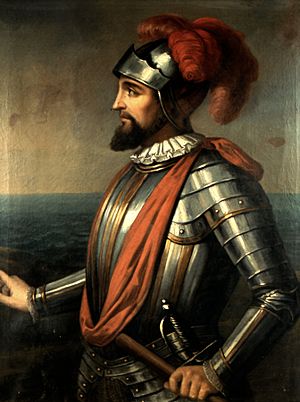
Spanish explorers first reached the Guajira Peninsula in 1499. In 1510, Vasco Núñez de Balboa founded the first lasting European settlement on the continent. Cities like Santa Marta (1525) and Cartagena (1533) were founded. In 1538, Gonzalo Jiménez de Quesada founded Santa Fe de Bogotá. This became the capital of the "New Kingdom of Granada." Other explorers founded cities like Cali and Popayán. They were all looking for gold and the legendary "El Dorado."
The Spanish brought enslaved Africans to the Americas. Indigenous people could not be enslaved because they were seen as subjects of the Spanish King. The Spanish Crown sold land to settlers, creating large farms and mines.
In 1717, the Viceroyalty of New Granada was created. Its capital was Santa Fé de Bogotá. This large area included parts of modern-day Venezuela, Ecuador, and Panama. Bogotá became an important center for Spain in the Americas.

In 1739, Great Britain declared war on Spain. Cartagena became a major target. A huge British force tried to capture the city. But many British soldiers got sick, and they had to leave. This battle was a big victory for Spain.
Becoming Independent: The Road to Freedom
For a long time, there were small rebellions against Spanish rule. But most were not strong enough to make a big change. A major movement for independence began around 1810. Colombia declared its independence on July 20, 1810. This day is now celebrated as Independence Day.
Simón Bolívar and Francisco de Paula Santander were key leaders in this fight. In 1819, Bolívar successfully led the fight for independence. The pro-Spanish forces were defeated.
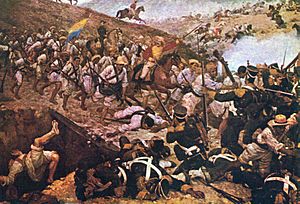
The territory of the Viceroyalty of New Granada became the Republic of Colombia. This new republic included modern-day Colombia, Panama, Ecuador, and Venezuela. Simón Bolívar was its first president. However, this new republic was not stable and eventually broke apart in 1830.
Modern Colombia came from one of the countries formed after Gran Colombia dissolved. Colombia was the first country in South America to have a constitutional government. The Liberal and Conservative parties, founded in the mid-1800s, are some of the oldest political parties in the Americas. Slavery was abolished in Colombia in 1851.
Internal disagreements led to civil wars. The most famous was the Thousand Days' War (1899–1902).
The 20th Century: Changes and Challenges
In 1903, Panama separated from Colombia. This happened with support from the United States. The U.S. later paid Colombia for its role in Panama's creation. Colombia and Peru also had a border dispute in the Amazon, which was settled by the League of Nations.
Colombia faced a difficult period called La Violencia (The Violence) from the late 1940s to the early 1950s. This was due to tensions between the two main political parties. It started after the assassination of a Liberal presidential candidate in 1948. The riots in Bogotá, known as El Bogotazo, spread across the country.
Colombia was the only Latin American country to send troops to the Korean War in the 1950s. After a military government, the Liberal and Conservative parties agreed to share power. This helped end La Violencia. However, new challenges arose.
In 1991, a new Constitution was put in place. This brought many positive changes to Colombian society.
The 21st Century: Peace and Progress

In the early 2000s, Colombia worked to improve security and grow its economy. Former President Juan Manuel Santos signed a peace agreement with a major guerrilla group in 2016. He received the Nobel Peace Prize for his efforts.
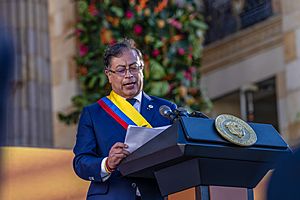
In 2022, Gustavo Petro became Colombia's first left-wing president. Colombia continues to work on improving its economy and relations with other countries.
Colombia's Amazing Geography
Colombia's geography is very diverse. It has six main natural regions. These include the Andes mountains, the Pacific Coast, the Caribbean coast, the Llanos (plains), the Amazon rainforest, and islands in both the Atlantic and Pacific oceans.
Colombia shares borders with Panama, Venezuela, Brazil, Ecuador, and Peru. It also has maritime borders with countries like Costa Rica and Jamaica.
East of the Andes, you'll find the savanna of the Llanos and the Amazon rainforest. These lowlands cover more than half of Colombia's land. But they have less than 6% of the population. The Caribbean coast has low plains and major port cities like Barranquilla and Cartagena. It also has the Sierra Nevada de Santa Marta mountain range, home to Colombia's tallest peaks.

The Andes mountains are a major feature in Colombia's interior. Most of Colombia's population lives in these highlands. The Andes split into three main ranges: the Western, Central, and Eastern Cordilleras. Bogotá, the capital, is located in the Eastern Cordillera at about 2,600 meters (8,500 ft) above sea level. This makes it one of the highest cities of its size in the world.
Colombia's main rivers include the Magdalena, Cauca, and Amazon. The Amazon River forms part of the border with Peru.
Colombia's Climate Zones
Colombia has many different climate zones. These depend on altitude, temperature, and rainfall. You can find tropical rainforests, savannas, steppes, deserts, and mountain climates.
- Below 1,000 meters (3,300 ft) is the tierra caliente (warm land). Temperatures are above 24°C (75°F). Most of Colombia is in this zone.
- Between 1,001 and 2,000 meters (3,300 and 6,600 ft) is the tierra templada (temperate land). Temperatures are between 17°C and 24°C (63°F and 75°F).
- Between 2,001 and 3,000 meters (6,600 and 9,800 ft) is the tierra fría (cold land). Temperatures are between 12°C and 17°C (54°F and 63°F).
- Above 4,000 meters (13,000 ft), it's glacial, with permanent snow and ice.
Amazing Biodiversity and Nature
Colombia is one of the world's most biodiverse countries. It has the highest number of bird species on Earth. About 10% of all species on Earth live in Colombia. This includes over 1,900 bird species, more than in Europe and North America combined!
Colombia also has:
- 10% of the world's mammal species.
- 14% of amphibian species.
- 18% of bird species.
- Between 40,000 and 45,000 plant species.
- The most endemic (found nowhere else) species of butterflies.
- The most orchid species.
Colombia is second only to Brazil in overall biodiversity, even though Brazil is much larger. The country has many protected areas, covering about 12.77% of its land.
Colombia's Diverse Landscapes
Colombia's different climates create many unique natural areas.
How Colombia is Governed
Colombia is a presidential democratic republic. This means people vote for their leaders. The government has three main parts:
- The executive branch is led by the President of Colombia. The president is both the head of state and head of government. They are elected for a four-year term.
- The legislative branch is the Congress. It has two parts: the Chamber of Representatives and the Senate. Members are elected by popular vote.
- The judicial branch is made up of four high courts. These courts handle legal matters and make sure the constitution is followed.
Colombia's Place in the World
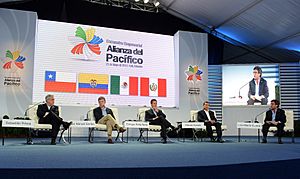
Colombia's foreign affairs are managed by the President and the Minister of Foreign Affairs. Colombia has diplomatic offices all over the world.
Colombia helped start the Pacific Alliance. This group helps countries in the region trade and work together. Colombia is also a member of the United Nations, the World Trade Organization, and the Organization of American States. It is also a partner of NATO.
Colombia's Military and Police
The President is the commander-in-chief of Colombia's armed forces. The military has three parts: the National Army of Colombia, the Colombian Air Force, and the Colombian Navy. The Colombian National Police works separately from the military. They are in charge of law enforcement across the country. Colombia has one of the largest armed forces in Latin America.
How Colombia is Divided
Colombia is divided into 32 departments and one capital district, Bogotá. Departments are like states. They are then divided into smaller areas called municipalities. Each department has a governor and an assembly that people vote for.
Some cities, like Barranquilla and Cartagena, are special districts. They have unique features.
Click on a department on the map below to go to its article.
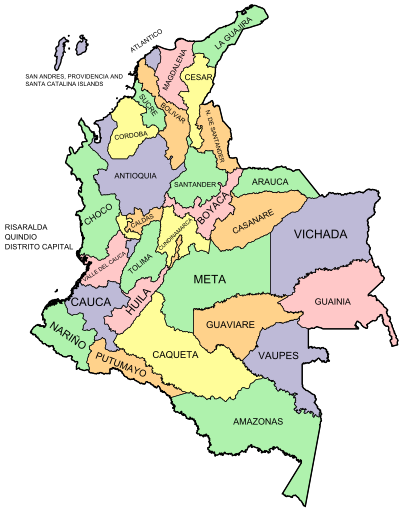
|
|
Colombia's Economy and Resources
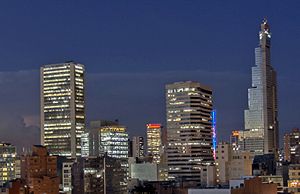
Colombia's economy has changed a lot. It used to be mainly about farming. Now, more people live in cities and work in industries and services. Most of the country's economic activity comes from people buying things.
Colombia's economy has grown steadily over the years. In 2007, it grew by 6.9%, one of the highest rates in Latin America. Colombia is rich in natural resources. It relies a lot on exporting energy and minerals.
Colombia's main exports include:
- Mineral fuels and oils
- Fruits and other farm products
- Sugars and food products
- Plastics and precious stones
- Metals and forest products
- Chemicals and medicines
- Vehicles and electronic goods
Its main trading partners are the United States, China, and the European Union. New trade agreements have helped Colombia export more different products to more places.

In 2017, about 26.9% of the population lived below the poverty line. The government is working to help more people access financial services.
Tourism is also growing in Colombia. It contributed about 2% to the country's economy in 2016. The number of foreign tourists has increased a lot.
Farming and Natural Riches
In farming, Colombia is one of the top 5 producers of coffee, avocado, and palm oil in the world. It's also among the top 10 producers of sugarcane, banana, and pineapple. Colombia is known for its high-quality coffee.
Colombia is a big exporter of coal and petroleum. In 2018, it was the 5th largest coal exporter. In 2019, it was the 20th largest petroleum producer. Colombia is also the world's largest producer of emeralds. It is among the top 25 gold producers.
Energy and Getting Around
Most of Colombia's electricity comes from renewable sources, especially hydroelectric power (from water). About 70% of its electricity is from hydroelectric plants. Colombia is recognized for its commitment to green energy.

Transportation in Colombia is managed by the Ministry of Transport. In 2021, Colombia had over 200,000 km (127,000 mi) of roads. The government plans to build more roads and improve transportation. This includes railway systems and port facilities.
People and Culture of Colombia
Who Lives in Colombia?
With about 50 million people, Colombia is the third-most populous country in Latin America. The population has grown a lot since the early 1900s. Most people live in the Andean highlands and along the Caribbean coast.
Colombia is a very urbanized country. About 76% of its people live in cities. Bogotá alone has about 8 million people.
Languages Spoken in Colombia
More than 99% of Colombians speak Spanish. But there are also 65 Indigenous languages, two Creole languages, and the Romani language. English is also an official language in the islands of San Andrés, Providencia, and Santa Catalina.
In total, about 101 languages are listed for Colombia. Most Indigenous languages belong to families like Chibchan and Tucanoan. About 850,000 people speak native languages.
Diverse Ethnic Groups
Human biological diversity and ethnicity-2018 Census White and Mestizo (87.58%) Afro-Colombian (includes Mixed) (6.68%) Amerindian (4.31%) Not Stated (1.35%) Raizal (0.06%) Palenquero (0.02%) Romani (0.01%)
Colombia has a very diverse population. Its people come from:
- Original Amerindian inhabitants.
- Spanish colonists.
- Africans brought as slaves.
- Immigrants from Europe and the Middle East in the 20th century.
Most of the population (87.6%) is a mix of white and mestizo (mixed European and Amerindian). About 6.7% are of African background. Indigenous Amerindians make up 4.3% of the population.
Africans were brought to Colombia as slaves starting in the 1500s. Large Afro-Colombian communities live on the Pacific Coast today. Many immigrants from the Middle East and Europe have settled on the Caribbean coast. There are also many Venezuelans who have moved to Colombia recently.
Religion in Colombia
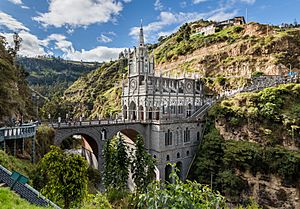
Most Colombians are Christian. About 70-79% are Roman Catholic. A smaller group (16.7%) are Protestant. About 4.7% of people are atheist or agnostic. Less than 1% follow other religions like Islam or Judaism.
Colombia's constitution guarantees freedom of religion. All religions are equally free under the law.
Health and Education
The average life expectancy in Colombia is 79.3 years. Healthcare has improved a lot since the 1980s. About 96% of the population has health insurance. Many Colombian hospitals are ranked among the best in Latin America.
Education is very important. Basic education is required by law. It includes primary school (grades 1-5) and secondary school (grades 6-9). After that, students can go to middle vocational education (grades 10-11). After high school, students can go to university or other higher education programs.
About 94.58% of adults can read and write. The government spends about 4.49% of its GDP on education.
Big Cities in Colombia
Colombia is a very urban country. About 77% of its people live in cities.
- Bogotá: 7,387,400 people
- Medellín: 2,382,399 people
- Cali: 2,172,527 people
- Barranquilla: 1,205,284 people
|
Largest cities or towns in Colombia
According to the 2018 Census |
||
|---|---|---|
| Rank | Name | Pop. |
| 1 | Bogotá | 7,387,400 |
| 2 | Medellín | 2,382,399 |
| 3 | Cali | 2,172,527 |
| 4 | Barranquilla | 1,205,284 |
| 5 | Cartagena | 876,885 |
| 6 | Cúcuta | 685,445 |
| 7 | Soacha | 655,025 |
| 8 | Soledad | 602,644 |
| 9 | Bucaramanga | 570,752 |
| 10 | Bello | 495,483 |
Colombian Culture and Arts
Colombia's culture is a mix of many influences. These include Native American, Spanish, African, and other European cultures. These influences have shaped Colombia's language, religion, food, and art.
Colombian Stories and Books

Colombian literature goes back to ancient times. In Spanish colonial times, writers like Juan de Castellanos and Juan Rodríguez Freyle were important. After independence, writers like José Asunción Silva and José Eustasio Rivera became famous.
One of the most famous Colombian writers is Gabriel García Márquez. He won the Nobel Prize in Literature for his book One Hundred Years of Solitude. Other important writers include Álvaro Mutis and Fernando Vallejo.
Visual Arts: Painting and Sculpture
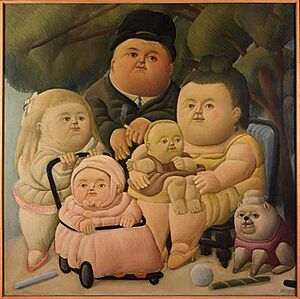
Colombian art has a history of over 3,000 years. Early people made ceramics and gold crafts. The San Agustín culture created large stone sculptures.
During Spanish rule, art was heavily influenced by Spanish Catholicism. Later, Colombian artists like Pedro Nel Gómez and Santiago Martínez Delgado started the Colombian Mural Movement.
Since the 1950s, Colombian art has developed its own unique style. Alejandro Obregón is seen as the father of modern Colombian painting. He painted Colombian landscapes with symbolic animals. Fernando Botero is another world-famous Colombian artist. He is known for his paintings and sculptures of large, rounded figures.
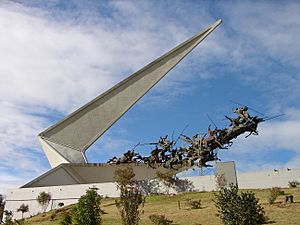
Buildings and Design
Colombia has many different architectural styles. These range from ancient indigenous buildings to modern ones.
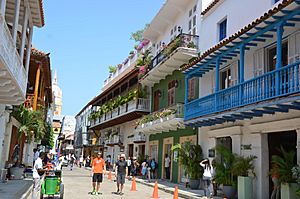
Ancient indigenous people built longhouses, crop terraces, and roads. They also created special burial sites. The Lost City is an ancient archaeological site with terraces carved into mountains.
During Spanish rule, European styles were adapted to local conditions. Forts were built to protect cities from pirates. Churches and schools were also important buildings. The National Capitol is a great example of 19th-century architecture.
Modern architecture in Colombia uses new materials like steel and concrete. Architects like Rogelio Salmona were very influential. Today, Colombian architecture focuses on using local materials and fitting into the natural landscape.
Music and Rhythms
Colombia has a rich and lively music scene. Colombian musicians like Shakira, Juanes, and Carlos Vives are famous worldwide. Colombian music mixes Spanish guitar, Indigenous flutes, and African drums.
- Caribbean music has rhythms like cumbia and vallenato. Cumbia uses maracas, drums, and flutes. Vallenato uses the accordion.
- Pacific coast music uses many drums, like the marimba. The currulao is a popular rhythm from this region.
- Andean music includes rhythms like the bambuco and pasillo. These are played with guitars and mandolins.
- Eastern Plains music (Llanos) uses the harp and a four-stringed guitar called the cuatro. The joropo is a fast rhythm with flamenco influences.
- Amazon music is influenced by Indigenous religious practices.
- Music from the Archipelago of San Andrés, Providencia and Santa Catalina includes Calypso and Polka.
Salsa music is also very popular throughout Colombia. The city of Cali is even called 'The New Salsa Capital of the World'.
Food: A Taste of Colombia
Colombia's food is influenced by its diverse nature and cultures. Dishes vary by region. Common ingredients include rice, corn, potatoes, and various meats and fish. Colombia also has many tropical fruits like cape gooseberry and passionfruit.
Some popular dishes are:
- Appetizers and Soups: Patacones (fried plantains), sancocho (chicken soup), and ajiaco (potato and corn soup).
- Snacks and Breads: Pandebono (cheese bread), arepas (corn cakes), and empanadas.
- Main Courses: Bandeja paisa (a large platter with meat, beans, rice), lechona tolimense (roasted pig), and tamales.
- Desserts: Buñuelos (fried dough balls), natillas (custard), and bocadillo (guava jelly).
- Drinks: Coffee, fresh fruit juices, and aguapanela (sugarcane drink).
Sports and Games

Tejo is Colombia's national sport. It's a team game where players throw metal discs to hit a target. But football (soccer) is the most popular sport in Colombia. The Colombian national team won the 2001 Copa América.
Colombia is also very good at roller skating. Its national team often wins at world championships. Cycling is another strong sport, with many Colombian cyclists succeeding in major races.
Baseball is popular in cities like Cartagena and Barranquilla. Many Colombian baseball players have played in Major League Baseball. Boxing has also produced many world champions for Colombia.
In motorsports, Juan Pablo Montoya is a famous Colombian race car driver. Colombia also excels in sports like BMX, judo, weightlifting, and bowling.
Images for kids
-
Amerindian population of Colombia by municipality in 2005.
See also
 In Spanish: Colombia para niños
In Spanish: Colombia para niños





